France entered the FIFA Women’s World Cup 2019 as one of the favourites but crashed out in the quarter-finals last week. The host nation never really kicked on and relied on the individual talent of their star players to plough through teams.
Having been untested in the group stages, the French edged their way past a dogged Brazilian side but were undone by a tactically disciplined United States side. After conducting an autopsy on their summer’s performance, the team had a few positives with one of them being French-Tunisian left-back Amel Majri.
Majri was one of the few bright sparks of a timid French team. Her energy and athleticism down the left flank required multiple defenders to stop her. Playing in her second World Cup, Majri has quickly become one of the more senior members of the squad after amassing 46 appearances for the national team. She has also made 118 appearances for her club side Olympique Lyonnais since joining them in 2010.
Before we can delve into this scout report, it is important to understand her upbringing to truly understand and appreciate the calibre of player we have in our midst.
Majri was born in Monastir, Tunisia along with her twin sister Rachida. Having moved to Vénissieux at the age of one, both sisters discovered their love for football in the Auvergne-Rhône-Alpes region of Lyon. Their uncle introduced them both to football and from there a fiery passion for the beautiful game was born. However, they were restricted from joining an academy early on due to poor financial stability and thus the decision was made to send Majri to AS Minguettes.
“In the street, there were three girlfriends who eventually joined me and we made girls against boys, she recalls. We had each taken the letters of our name to found the team MARS as we were only four, we always took a boy … to put him in goal! It was a bit of the world upside down.” – Amel Majri
After growing up through hardship, we take a closer look at Majri and why she’s regarded as one of the best players in women’s football. This tactical analysis will explain her technical and mental qualities and how she utilises them to great effect for both club and country.
Amel Majri – Tunisian born, French bred
Majri is a natural left-sided midfielder who was converted to starting left-back when Corinne Diacre took over the French National Team. Her attacking prowess combined with her incredible defensive qualities was ideal for France’s high octane style of play and compliments Eugenie Le Sommer’s play style at left wing.
Le Sommer adopts the role of an inside forward allowing Majri to make marauding, overlapping runs forcing the opposing defender to make a choice whether to stick with Le Sommer or contain the full-back. Her attacking qualities have seen be used as France’s primary attacking weapon along with her most potent weapon, her accurate crossing. More often than not, Majri’s crosses reach her intended target giving them every opportunity to score.
Now that we have a better understanding of her play style, we will look into the technical qualities that have made her into arguably the worlds best-attacking left-back.
Tactical Analysis – Movement, dribbling & crossing
Modern full-backs are judged on their attacking and defensively output. Majri’s core fundamental strength is her attacking play through her exceptional positioning, crossing, and dribbling. The Lyon defender excels at driving into the opposition’s defence wreaking havoc whilst creating space for her teammates. Her presence in the final third creates an extra body during France’s transitions and pressing movements by luring defenders in freeing up space in other areas.
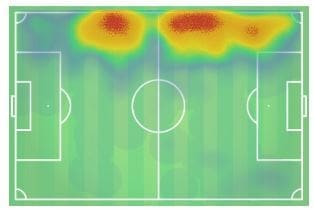
The statistics below show support her attacking prowess. Majri attempts 3.84 crosses per 90 along with her 4.26 dribbles per 90. The statistics show that the French-Tunisian left-back almost provides a cross with every dribble attempt. The perfect statistic when looking at your left-back’s attacking output.

Majri’s ability to utilise exquisite positioning allows her to often provide her teammates with a passing option. Once in possession, the Lyon left-back backs herself in one v one situations and looks to beat her marker to put in a cross before she can be closed down.
Blessed with incredible speed, Majri’s dribbling pushes her opposite number back, making room for her wing partner to take advantage. Lyon’s left-back’s biggest strength includes her dynamic dribbling and one v one ability; however, her accurate crossing is surely her greatest asset. Both Ada Hegerberg and Valerie Gauvin profit from her pinpoint crossing. She is often able to find space and time to cross in devastating fashion. She attempts 3.66 crosses per 90 to go along with her 1.11 progressive runs, backing up her attacking nature and style of play.
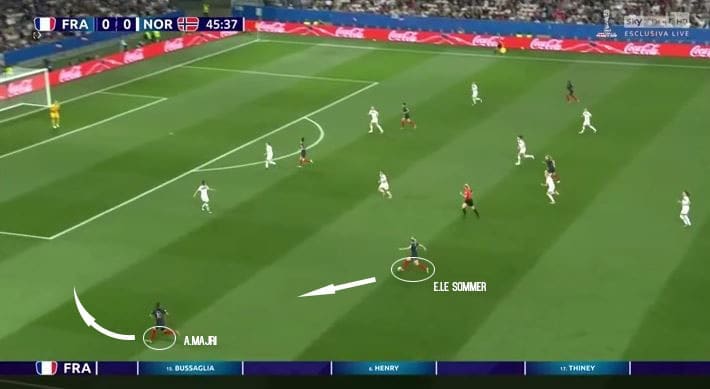
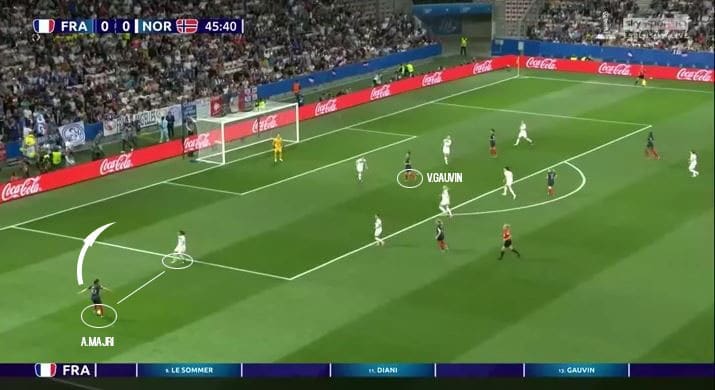
As the graphics above highlight, Majri is able to stay within range of Le Sommer with the Norwegian defensive midfielder failing to close down the left winger. As the left-back receives the ball she looks up to scan the penalty area, finding Gauvin as her primary target sending in a pin-point cross to attack.
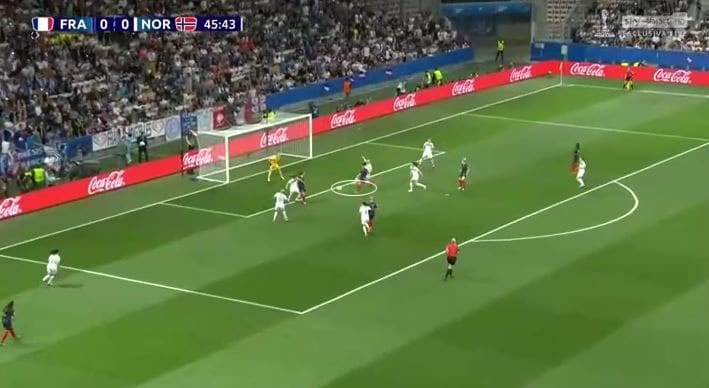
Along with her superior crossing ability, Majri excels in one v one situations. A full-back’s requirement includes beating their marker. Whether it’s through pace, intelligent positioning or interchanging passes, Majri can do all three. Because her playstyle revolves around her athleticism, she usually thrives on space to move the ball forward and create crossing chances.
However, she has also proven to be equally adequate in smaller spaces, gliding through multiple defenders. Not only does she push the ball forward, it moves players out of position for her teammates to thrive in.
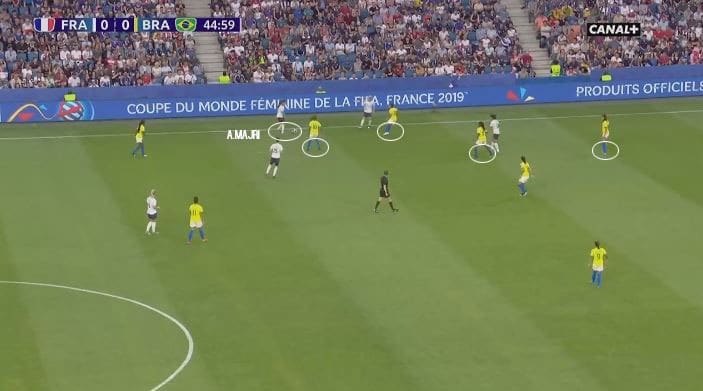
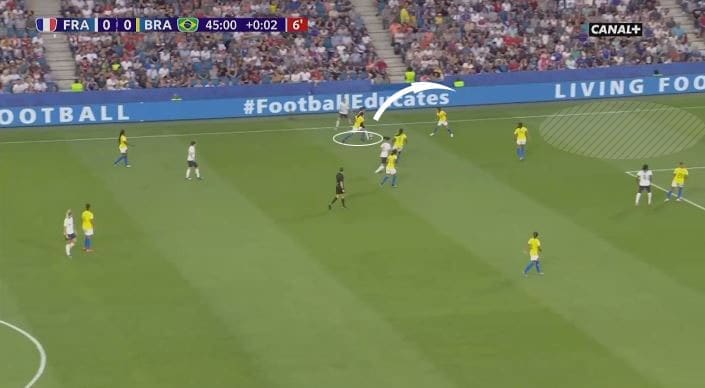
As the above graphics show, Majri is faced with multiple Brazilian defenders with no clear passing option. The French left-back turns to her superior dribbling to force the Brazilian defenders to try and dispossess her, eventually creating space for her and her teammates to drive into to create a crossing opportunity. This has also created a gap for Gauvin to move into with every player focused on Majri’s movement. Gauvin could potentially ghost through unnoticed and be on the end of a Majri cross.
Link up play
As we indicated earlier, Majri’s style of play is better suited to a system that induces wide play. Whether it’s in France or Lyon’s 4-2-3-1 formation, both managers have tailored the role to allow Majri the freedom to cause problems down the left wing, while Bronze or Torrent play a more conservative and inverted full-back role. Majri’s FIFA Women’s World Cup stint was trademarked by her marauding runs and most importantly her link-up play with her midfield teammates.
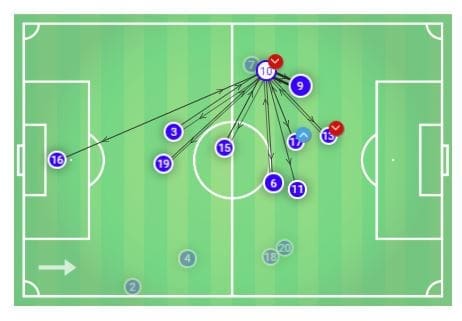
With Majri being a central figure to France’s attacking play, the above pass map from the FIFA Women’s World Cup match against Brazil highlights her importance to the tactics. More than half the team interchanges passes with the Lyon left-back. Combined with her heat map above, we can conclude that the team does truly run every attacking move through Majri.
France’s system also involves the use of a target man in Gauvin. The Montpellier forward has profited the most as she thrives on long crosses into the penalty area. While Majri provides Gauvin with impeccable service, it is, however, her partnership with attacking left forward, Le Sommer that is most prominent.
Their partnership for France becomes more beneficial due to their consistent play time together for Lyon. Majri and Le Sommer’s play styles are extremely complimentary with the full-back excelling at overlapping runs whilst Le Sommer prefers central runs through the channels. In most matches, you will notice both players often giving one another a passing option. The pass map proves this point with Majri and Le Sommer often stationed within a short passing range of each other.
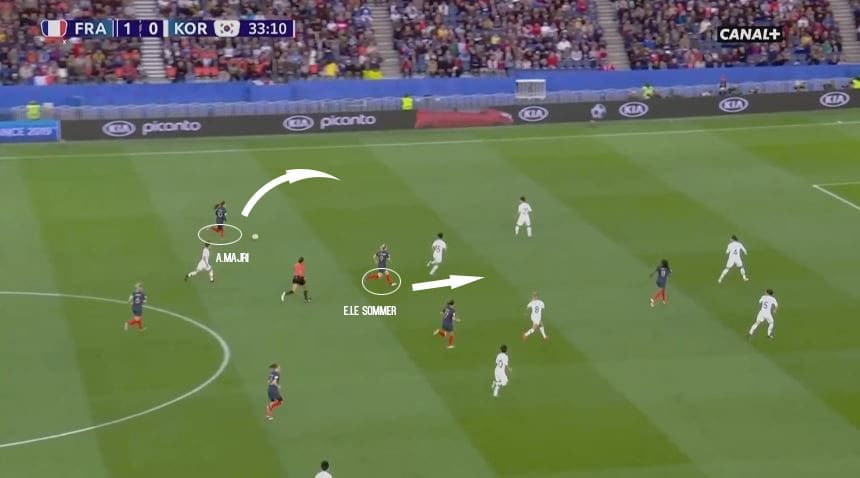
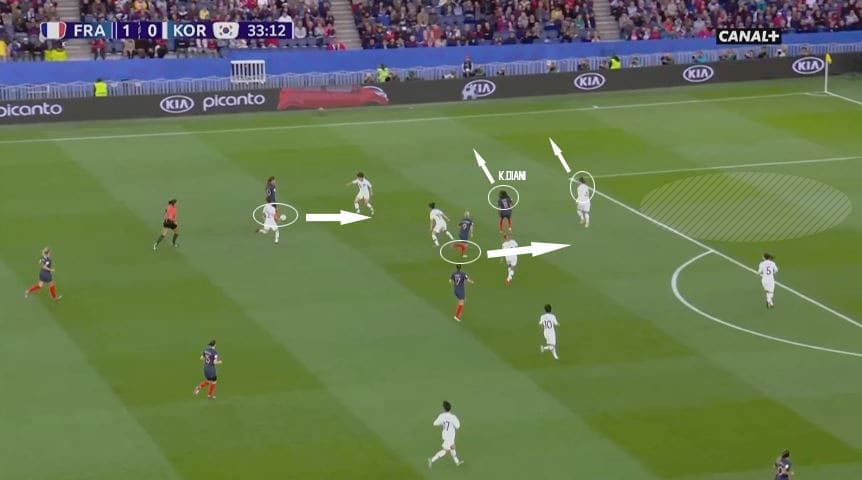
This example against the Korea Republic portrays her understanding adequately. Majri and Le Sommer began a series of passes from a deep position initiating a counter-attack. As they arrive at the crowded Korean penalty area, Majri’s almost telepathic sixth sense kicks in and is able to spot Le Sommer’s darting run through a sea of Korean bodies. The end result sees Le Sommer exploiting the empty spaces in behind the defence creating a goal scoring opportunity.
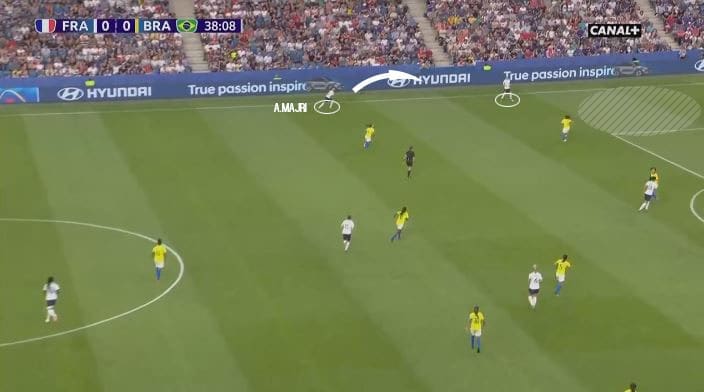
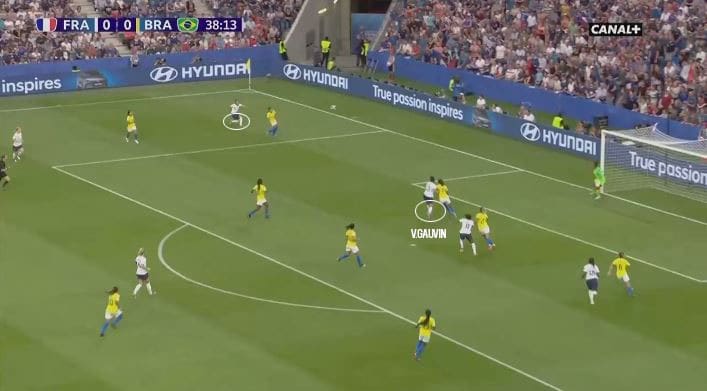
Whilst excelling in passing within tight spaces, Majri thrives on larger empty spaces created by teams chasing a goal. In this example against Brazil, Le Sommer is in possession with Majri attempting a neat overlapping run. Notice, the ample amount of space the left-back has to run in behind. Using her extreme pace, Majri is able to deliver a cross with almost no pressure towards Gauvin.
Defensive stalwart?
While most of this scout report has portrayed Majri as a potent attacking force, her defensive qualities are equally adept and have improved over time. We will take a closer look at the statistics that back up her defensive game. Below is a summary of Majri’s statistics for France and at first glance, we can assess her to be a highly proficient left-back in a defensive capacity too.

One particular statistic that stands out is her recovery average of 8.55 per 90 minutes with a 42.9% success rate. Majri is often positioned higher up the pitch and will look to intercept and close off any passing lanes. This highlights her strength in defensive one v one situations. Majri’s 8.55 attempts is another indicator of France’s preference to overload the wide areas and attack quickly through her.
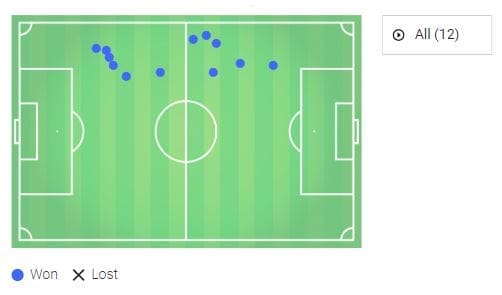
This recovery map against Brazil in the FIFA Women’s World Cup shows that 50% of her recoveries were made in the opposition half allowing France to turnover possession and attack Brazil. That game, in particular, was very wing focused with the two French full-backs just about getting the better of Brazil’s wide players thus proving the importance of both Majri and Torrent.
So how do these statistics translate on the field? The examples below should answer that question.
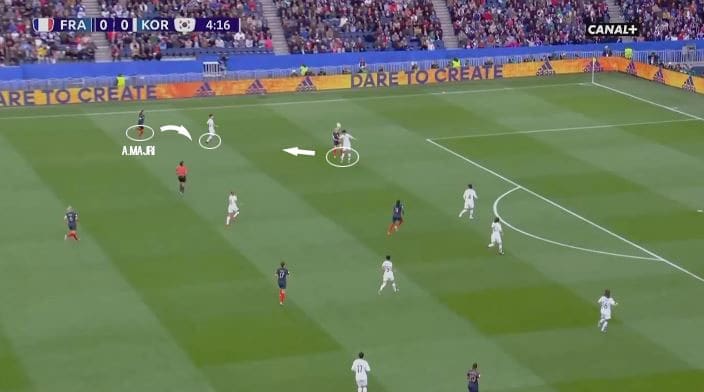
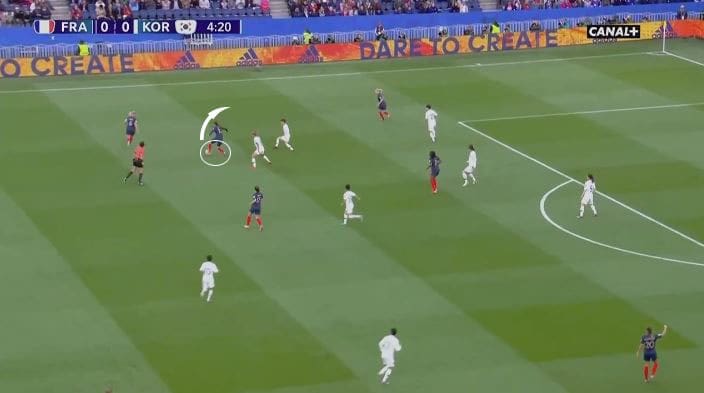
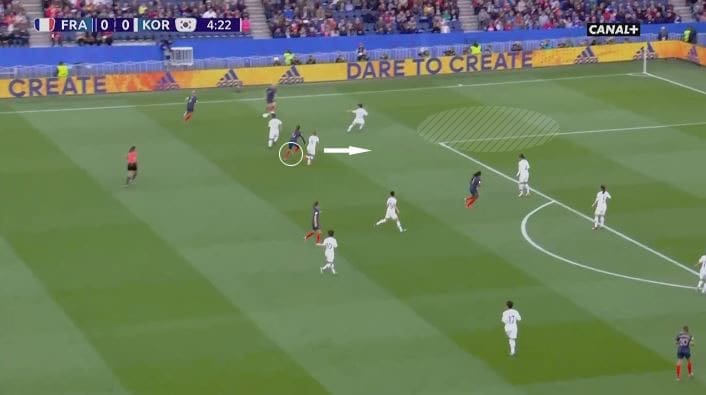
The above example highlights her defensive capabilities in an attacking sense. Majri’s anticipation has been a key component to her defensive game. In each of these examples, we can see her use her anticipatory skills to successfully thwart the danger.
In the first example, we can see Majri’s high positioning as France look to win the aerial duel. As Le Sommer wins the header, the ball goes towards the nearest defender, however, the Korean defender is unaware of Majri’s position as she darts in front her to win back possession.
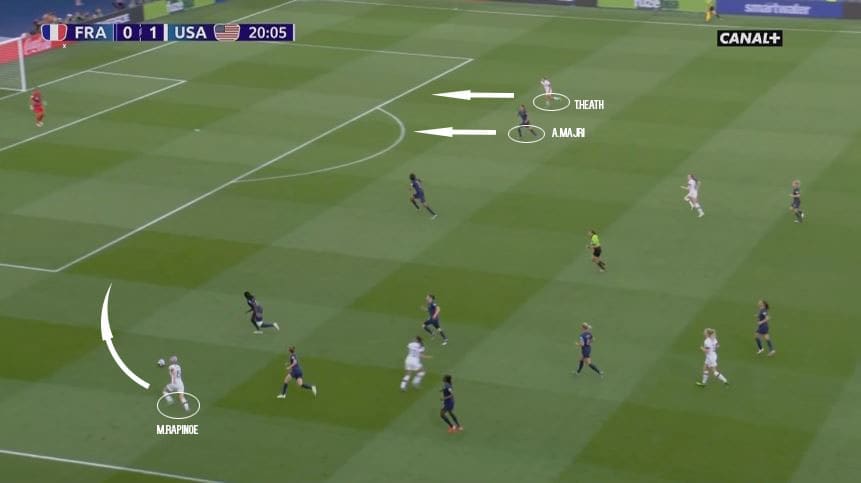

The second image exemplifies Majri’s speed and anticipation. The USA often run play through their wide players and this phase of play is no exception. Megan Rapinoe chases a through ball down her wing with Tobin Heath attempting a run into the penalty area on the far side. Majri is aware of Heath’s positioning and uses her blistering speed to keep up with the Portland Thorns winger. As Rapinoe releases the cross, Majri is in a better position to nullify Heath’s threat.
She goes again
After a thorough analysis, we can conclude that Majri is in every sense of the word a modern full-back. She’s quick, agile and contributes equally in both defence and attack. France and Lyon both look at their full-backs as core fundamental parts of their tactics and strategy. Majri gives them reliability, offensive dynamism and a defensive calmness in her high octane style of play.
This scout report was aimed to portray her excellent FIFA Women’s World Cup and what we can expect from her in the upcoming domestic season ahead with Lyon. With a new manager at the helm, it will be interesting to see how Jean-Luc Vasseur aims to set up this highly successful side who were near flawless under Reynald Pedros. However, one thing is certain; Majri remains a key member of the first team squad and is one of the first names on the team sheet.
If you love tactical analysis, then you’ll love the digital magazines from totalfootballanalysis.com – a guaranteed 100+ pages of pure tactical analysis covering topics from the Premier League, Serie A, La Liga, Bundesliga and many, many more. Buy your copy of the June issue for just ₤4.99 here, or even better sign up for a ₤50 annual membership (12 monthly issues plus the annual review) right here.

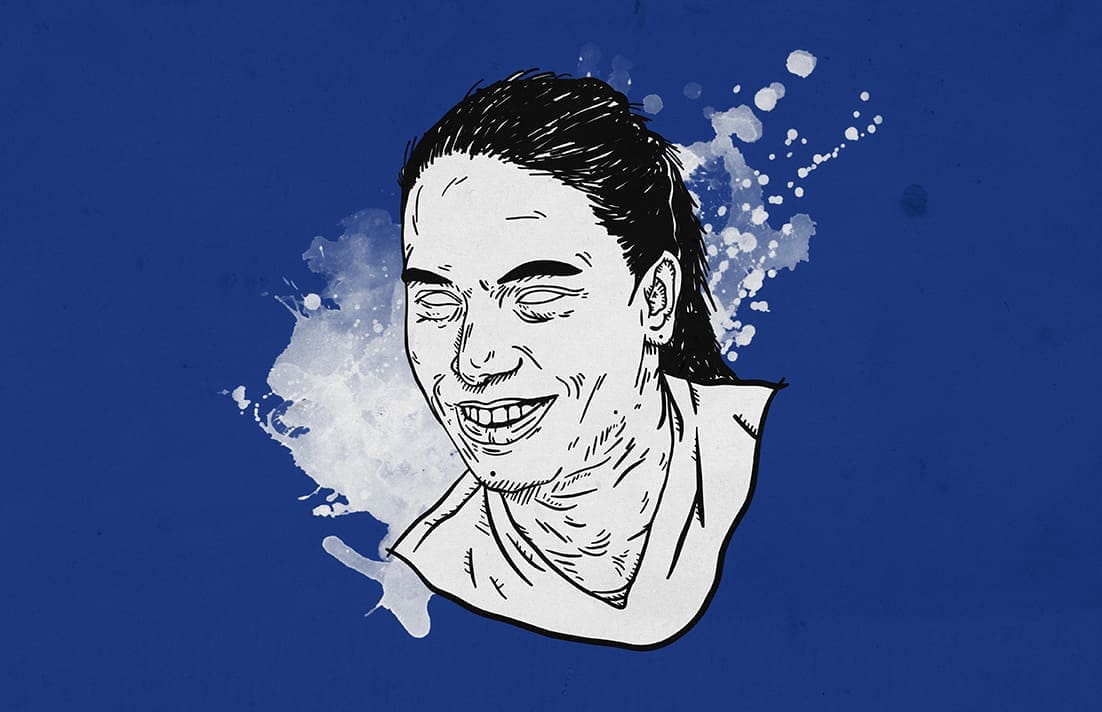




Comments